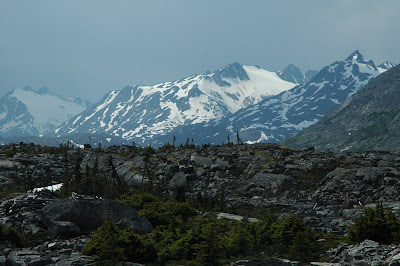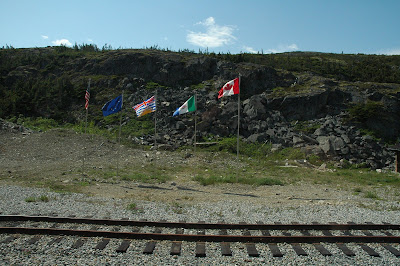
 Homer has the feeling of a Town with a split personality. Two sections, separated by about 4 miles, have a completely different look and feel and seem to offer different opportunities. You enter Homer through what I would call a downtown or business area. There are some unique shops and restaurants, several great museums, trails to Bishop Beach, schools, and municipal offices. A regular kind of town.
Homer has the feeling of a Town with a split personality. Two sections, separated by about 4 miles, have a completely different look and feel and seem to offer different opportunities. You enter Homer through what I would call a downtown or business area. There are some unique shops and restaurants, several great museums, trails to Bishop Beach, schools, and municipal offices. A regular kind of town.Drive the 4 miles or so out to what is called the Homer Spit and here you find the other side of Homer. Lots of brightly painted shops, housed in individual units built on posts over the water, dozens and dozens of charter operations offering every kind of trip from kayaking, bear watching, halibut fishing, to evening dinner cruses. There is a local theatre group and galleries showing local artists creations. RV parks abound along the beach and boats and marinas fill in all the spaces. Quite a lot packed into this short spur of land that juts out into Kachemak Bay. This bay is an offshoot of the Cook Inlet.

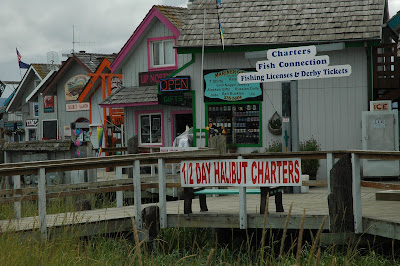
 Homer Spit on the left sticking out in the bay
Homer Spit on the left sticking out in the bayAt the Pratt Museum there were two exhibits about the 1968 Valdez Oil spill that were informative as well as emotionally compelling. The spill of 11 million gallons of crude oil into Prince William Sound occurred on March 23, 1989. It was the largest oil spill in any U.S. waters and eventually spread a deadly oil slick along 1,400 miles of shoreline.
At the 20th anniversary of this accident, scientists are still studying the long-term affects. Recent and ongoing projects indicate that bird, sea otter, and Orca populations have not yet returned to pre-spill levels, and a summer long study, which dug 9000 pits on the shore, to assess how much oil was remaining after 20 years, found that an estimated 20,000 gallons of oil still remains about 5 inches below the surface.
The presentation was arranged with short stories from local citizens and cleanup volunteers, mixed with statistics on the costs and animal losses. There was a black and white photography exhibit showing 20 or 30 photos of the clean up and comments from participants. Today, this spill, that occurred 20 years ago, continues to impact bird and animal life.
Just north of Homer, while camped at Anchor Creek, we received a call from Sharon and Francis Morrow, the couple from Rockland, Maine that we met in Prince Rupert. We enjoyed a couple of days with them at the Anchor Creek campground. Marlin and Francis fished the Creek and Sharon and I combed the beach.
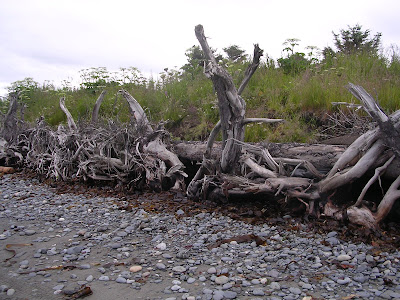 I liked this idea for a retaining wall on the beach. One root end was buried in the sand
I liked this idea for a retaining wall on the beach. One root end was buried in the sandDozens and dozens of eagles roosted in the area where the river enters the ocean. One morning I counted 10 in one tree with about 5 more nearby. I thought they were waiting to catch some fish, but a local told me they were waiting for the Salmon to die so they could get an easy meal. These birds were so used to people that you could walk within 30 feet of them and they would not fly away. Many were immature but at least a third of the ones we saw were adult eagles. We even watched while an adult intimidated two immature birds off their perch. She was either an elder demanding respect, or their mother who was not happy with what they were doing or how they were doing it.
 Anchor Beach immature Eagle
Anchor Beach immature EagleThis area is famous for Halibut fishing and the charter boats are launched into the ocean from the beach using tractors. Sharon and I were returning from a long walk one afternoon when the fishing boats were coming in for the day. We were surprised when the tractors, hitched onto a trailer, then backed into the breakers till the water was almost over their wheels. Even more surprising was how fast the boats propelled themselves onto these trailers. Apparently they must keep their speed up so the back end of the boat does not sink down and scrape the bottom.


Tractor Launching at Anchor Beach


Leaving the Kenai Peninsula we headed back toward Anchorage stopping at Bird Creek to witness what is called “combat fishing”. When the salmon are running, any river can look like this. It is truly a family affair, with grandparents, parents and kids all giving it a try. We even saw a young woman coxing her grandmother along the slippery bank and getting her tackle prepared for her so she could fish.
 Bird Creek, just south of Anchorage. "Combat Fishing"
Bird Creek, just south of Anchorage. "Combat Fishing"

We only spent one afternoon in the city of Anchorage. It has a busy downtown section decorated with a multitude of colorful hanging pots and vivid gardens. The city sponsors “Wild Salmon On Parade” where artists decorate salmon models and they are displayed throughout the city. My favorite was Bar-King Salmon, a fish covered with bark scales. Another, a take off on the famous Ship Creek in downtown Anchorage, called “Up Ship Creek without a Paddle”, pictured several pairs of boots in a streambed along with a salmon.





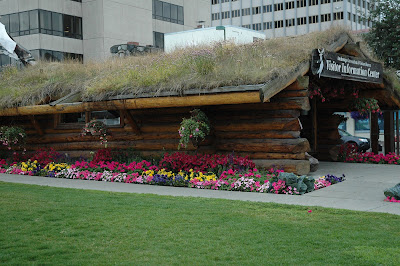
 Our last departure from the Alaska Marine Highway
Our last departure from the Alaska Marine Highway Chilkoot Lake. The campground was along the left side of the lake
Chilkoot Lake. The campground was along the left side of the lake









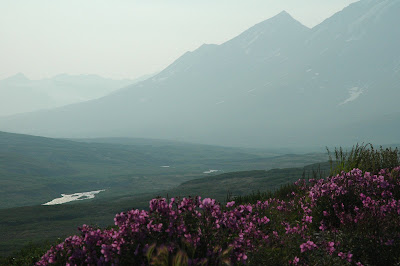















 Coming into Juneau again with the Mendenhall glacier in sight
Coming into Juneau again with the Mendenhall glacier in sight Steam Engine 73 all decked out for the fourth of July. I took this from our camper
Steam Engine 73 all decked out for the fourth of July. I took this from our camper





























